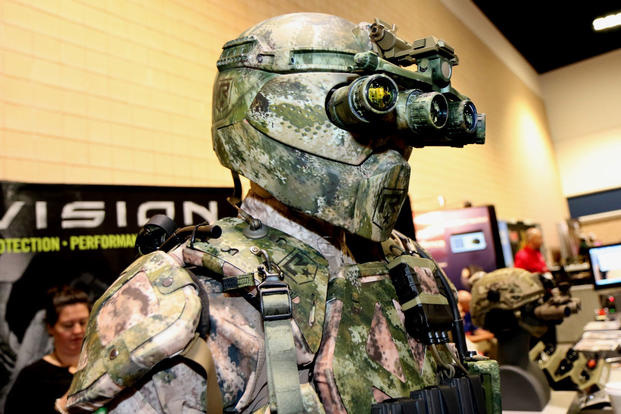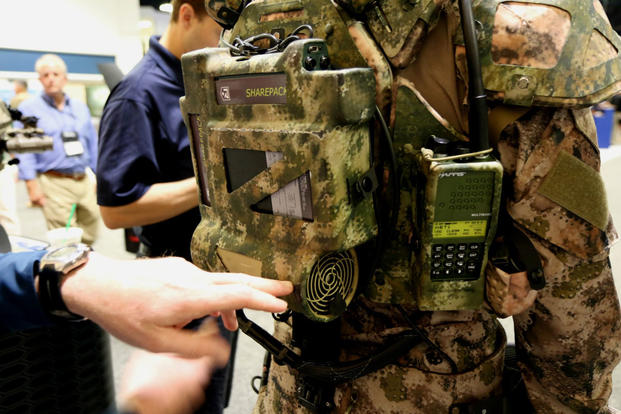TAMPA, Fla. – Defense firms tried to dazzle special operations officials here in hopes of one day being selected to build the command's futuristic operator suit -- typically referred to as the Iron Man suit.
U.S. Special Operations Command launched its effort to create the highly-advanced, Tactical Assault Light Operator's Suit, or TALOS, in 2013 to "provide comprehensive ballistic protection and peerless tactical capability," Gen. Joseph Votel, commander of U.S. SOCOM, told an audience here at the 2015 Special Operations Forces Industry Conference.
"Advanced armor, cutting-edge power sources and integrated display systems are just a few of the results this project has already yielded," Votel said. "This past year, SOCOM collaborated with industry to develop the military's first-ever, untethered, loadbearing, powered exoskeleton to augment human performance."
SOCOM has also instituted a "prize challenge to accelerate tactical development and leverage the most creative minds that our nation has to offer," Votel said adding that if all goes well, the command will have "the first of its kind, fully-integrated, independently-powered prototype by the end of August 2018."
Votel's praise of Joint Acquisition Task Force-TALOS inspires confidence, but it's difficult to gauge the progress of the TALOS effort because program officials are saying very little.
JATF-TALOS held a few sessions here for firms to present "five-minute solution" presentations to show how they would be of value to the effort. But so far, there have been no public briefings on the program's activities. And no one was allowed to take pictures or video of the well-crafted interactive, digital display that depicted what a TALOS-equipped operator would look like.
Navy Cmdr. Anthony Baker, the head of JATF- TALOS, was reluctant to talk about the program when reporters approached him at the session.
"We have powered exoskeletons on contract being developed; the foundation is the exoskeleton," he said. "All I can say is 'we are shooting for the vision,'" which calls for "increased armor protection, increased situational awareness, increased lethality, increased, human performance."
"It's a very ambitious vision," he said. "There are a number of theories we are working on that are making significant progress."
Revision Military's Kinetic Operations Suit
Despite SOCOM's secrecy, there was one company at SOFIC that boldly displayed its attempt to bring the TALOS vision to reality.
The full-size mannequin wearing Revision Military's Kinetic Operations Suit looked alien with its fully-enclosed helmet and quad-tube night-vision device.
Revision's suit features hard, body armor protection, capable of stopping rifle rounds, that covers 60 percent of the operator – compared to the 18 percent armor coverage operators currently wear.
It also features a powered, lower-body exoskeleton, to transfer the additional weight of the armor down to the waste belt and supports it with motorized actuators on each leg, according to Brian Dowling, program manager.
"This is a developmental program launched about a year ago, and we are trying to follow some of the same tenets as the TALOS program," he said.
It's designed to "know when you are about to walk and it picks your leg up and moves it for you, but it also takes the weight from this kit off of some of those weak areas like the neck and the lower back," Dowling said.
The weight on the helmet, armor and vest is transferred down through a rigid, articulated spine. The suit features a small power pack and cooling system that's worn on the back. It powers the suit and is connected to a cooling vest that the operator wears beneath the suit. The cooling system pumps water through about three yards of tubing to keep core temperature steady, Dowling said.
Revision's suit "has actually gone under live-fire testing with the SOF community, and we have done a comparison of traditional operators kit in a live-fire scenario and this kit in a live-fire scenario to ensure that the same level of tasks could be done in the same amount of time – it was successful," Dowling said. "So you can wear 60 percent more armor and still accomplish the same level of tasks."
Quiet Power Sources
One of the challenges of this effort will be to find a power source that runs quiet.
General Atomics officials presented its plans to supply TALOS with a hybrid-electric power unit that consists of an internal combustible engine that fits in the palm of the hand that will run at 10,000 RPMs.
The problem with commercially-available motors is most of them are "very noisy," according to the General Atomics official. A possible solution would be a new, liquid-piston engine that is now in development and is projected to run quiet.
The system could run for a limited amount of time on battery power when stealth is necessary, the official said.
Revision's power pack is not completely silent, Dowling said.
"There is some noise, "he said, explaining that in close proximity, the cooling fan can be heard.
"It was designed for direct action missions, so all the components allow you to turn off all the systems," Dowling said. "The thought is once the first breach happens – boom – after that there is very little quiet that goes on in a direct action mission.
"You can be stealthy for that 100 yards approaching a door, but once you blow a door off, it doesn't matter."
SOCOM intends to funnel $80 million into research and development over the first four years.
That's not much compared to other advanced military programs that have taken years to perfect and cost hundreds of millions of dollars.
The Army is now equipping combat units with a secure, smartphone device -- known as Nett Warrior -- that allows a leader to track subordinates' locations in relation to his own position via icons on a digital map. The unit leaders can view satellite imagery and even send text messages.
The technology has seen combat and given leaders a precise view of their tactical environment, empowering units to operate more decisively than ever before.
But the program's success did not come easily. Land Warrior, the first generation of this computerized command-and-control ensemble, was plagued by failure. From its launch in 1996, the Army spent $500 million on three major contract awards before the system's reliability problems were solved in 2006.
-- Matthew Cox can be reached at Matthew.Cox@military.com.





























